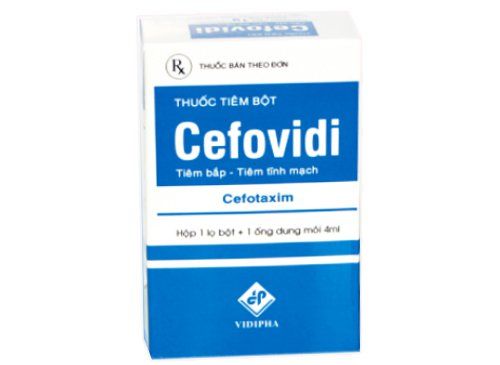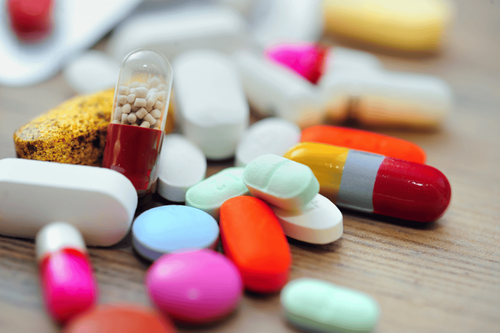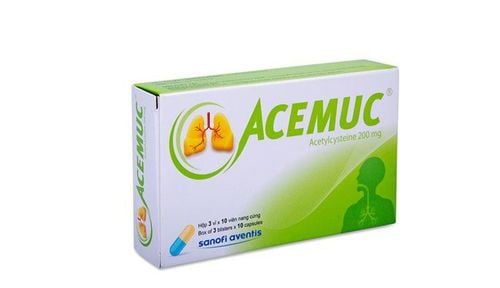This is an automatically translated article.
With the main ingredient is Cefotiam, Kontiam drug is effective on many Gram (-) and Gram (+) bacteria. So Kontiam is effective in the treatment of any diseases. Please refer to the article below!
1. Uses of Kontiam
Kontiam medicine has the main ingredients Cefotiam (in the form of Cefotiam hydrochloride) 1g and anhydrous sodium carbonate. Therefore, the use of the drug is the use of Cefotiam. This is a third generation Cephalosporin antibiotic that is effective against many Gram (-) and Gram (+) bacteria such as Staphylococcus, Streptococcus, Streptococcus pneumoniae, Haemophilus Influenzae,... This antibiotic has anti-coccidioid activity. Gram (+) is not strong but has the ability to inhibit some beta-lactamases of Gram (-) bacteria and is strongly active against Enterobacter.
Therefore, the drug Kontiam use is indicated in the following cases:
Sepsis Infection of the burn or incision. Osteomyelitis Spondylitis, septic arthritis. Bronchitis, pneumonia, patients with lung infections, tonsillitis. Inflammation of the middle ear. Nephritis, cystitis, urinary tract infection, prostatitis. Sinusitis On the other hand, experts recommend, Kontiam is not allowed to be prescribed to people with a history of shock with cefotiam or allergy to Beta lactam antibiotics.
2. Usage and dosage of Kontiam
2.1. How to use Below are instructions for using Kontiam in 2 forms: intravenous injection and infusion. The patient, regardless of the form of medication, needs the support of medical staff.
For intravenous form: Kontiam drug is dissolved with distilled water for injection, isotonic sodium chloride solution and 5% glucose solution. For the infusion form: dissolve Kontiam dose 0.25 - 2 g into the infusion solution such as glucose solution, electrolyte solution, amino acid solution... Perform infusion within 30 minutes to 1 hour lake. 2.2. Dosage The dose of Kontiam is adjusted by the doctor based on age, physical condition, and treatment goals. Below is a reference dose:
Adults: Intravenous 0.5 - 2g/day, divided into 2-4 times Children: Intravenous injection 40-80 mg/kg body weight/day divided into 3-4 time. The dose to treat sepsis in adults can be up to 4 g/day. The dose for the treatment of severe or persistent infections (eg, sepsis, meningitis) in children may be increased to 160 mg/kg/day. Patients with renal impairment: Patients with renal impairment with a creatinine clearance of 16.6 ml/min may receive the same dosing regimen as patients with normal renal function. In the case of creatinine clearance <16.6 ml/min, the dose should be reduced to 75% of the dose for patients with normal renal function with dosing intervals every 6 or 8 hours. The drug Kontiam has not recorded cases of missed doses. Because the drug is injected by medical personnel. In case of overdose, the patient may experience symptoms such as nausea, abdominal pain, digestive disturbances, even convulsions. At that time, the patient will be asked to stop using the drug and depending on the symptoms to have an effective treatment method.
3. Kontiam side effects
In addition to the treatment of the disease, Kontiam medicine can also cause some side effects for patients such as:
Patients may experience symptoms of hypersensitivity to the drug with manifestations such as: rash, urticaria. urticaria, itching, fever... In case the patient is in shock, it should be treated promptly. Record cases of patients experiencing Steven - Johnson's syndrome or epidermal necrolysis. Rarely, hematologic reactions such as granulocytopenia, thrombocytopenia, or eosinophilia may occur. Gastrointestinal symptoms are more common such as abdominal pain, diarrhea, intestinal conjunctivitis Patients may also experience some undesirable respiratory symptoms such as cough, fever, shortness of breath ... The above are not all side effects that you may experience while taking Kontiam. Therefore, if you encounter any unusual symptoms that are suspected to be caused by the drug, you also need to notify your doctor to receive timely advice.
4. Drug interactions
For safe use, your doctor will not prescribe Kontiam with Cephalosporin antibiotics or with diuretics such as Furosemide. Because these drugs can cause drug interactions that reduce the effectiveness of Kontiam or increase side effects, seriously affecting the patient's health.
Therefore, before prescribing, you need to inform your doctor about the drugs and functional foods you are using.
5. Notes when using Kontiam
Here are some groups of subjects to keep in mind when there is a need to use Kontiam:
Pregnant women and nursing mothers: This is a group of subjects that need to be cautious when intending to use Kontiam. use medicine. Because there are not enough studies and only use the drug when absolutely necessary and have to weigh the benefits and risks. As mentioned above, Kontiam drug can cause side effects such as headache, dizziness... Therefore, people who often operate machinery and drive should be cautious when taking the drug. Poor nutrition, parenteral nutrition, elderly, exhausted. Hematologic monitoring is required in these patients because hemophilia may occur due to vitamin K deficiency. In short, Kontiam is an antibiotic that is effective against many types of bacteria. However, the drug can cause unwanted side effects. Therefore, patients need to strictly follow the doctor's instructions on dosage and usage of Kontiam.
Please dial HOTLINE for more information or register for an appointment HERE. Download MyVinmec app to make appointments faster and to manage your bookings easily.













